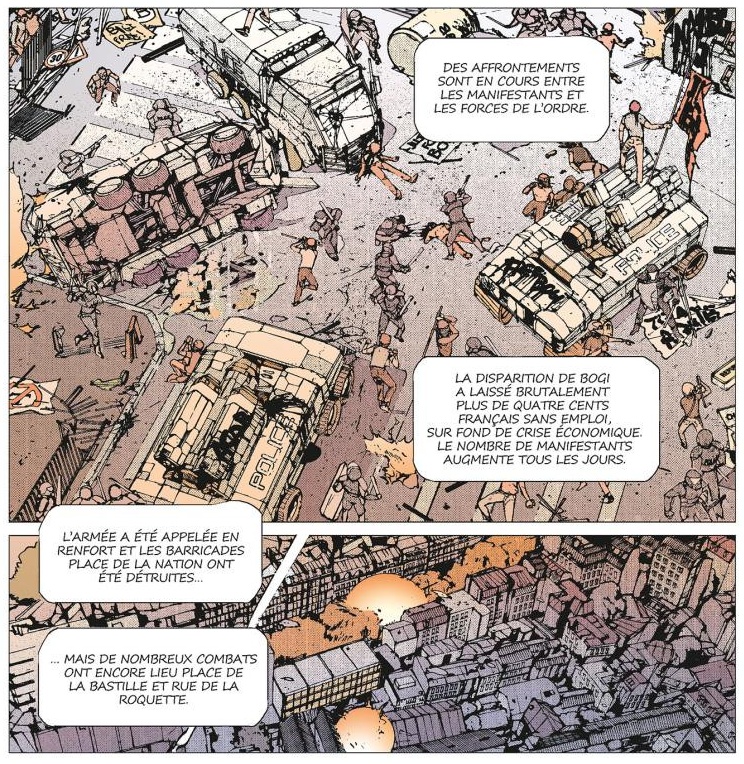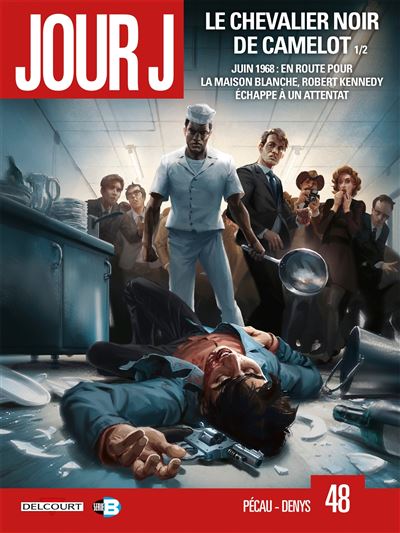As Facebook launches its disappointing virtual universe, how about entering the Bolshoi Arena? This science fiction series is a real punch in French comics by its visual splendor and its scenario as innovative as realistic.
Real and virtual anarchy
 Bolshoi Arena is an anticipation series, a science fiction series set in the near future. The world is now divided into two: the real world and the virtual world of the Bolshoi. A large part of the Earth's population now lives in a few megacities with a population so large that one has the feeling of suffocating as soon as one sets foot outside one's apartment. To cope with this situation, most of the inhabitants take refuge in the virtual and infinite world of the Bolshoi. This popular universe has become a huge source of profit. Powerful multinationals including Titanica and Bogi are fighting to gain power over these potential customers. On land, these corporations also become the main employers. Bolshoi Arena follows the adventures of a young woman, Marje. Since the previous volume. She is stuck in the Bolshoi while her body is in a coma. Marje revealed that BOGI is run by artificial intelligences but, in the real world, this revelation causes a tidal wave of layoffs and therefore riots in Paris and the beginning of civil war in South Africa. Marje leaves for space thinking to cause the lag that will trigger the death of her body. But she discovers two planets where fauna and flora have developed without any human intervention. The girl wants to do everything to avoid a colonization of virgin planets. But how can this Eden be protected from the greed of the Bolshoi crowd and the multinationals?
Bolshoi Arena is an anticipation series, a science fiction series set in the near future. The world is now divided into two: the real world and the virtual world of the Bolshoi. A large part of the Earth's population now lives in a few megacities with a population so large that one has the feeling of suffocating as soon as one sets foot outside one's apartment. To cope with this situation, most of the inhabitants take refuge in the virtual and infinite world of the Bolshoi. This popular universe has become a huge source of profit. Powerful multinationals including Titanica and Bogi are fighting to gain power over these potential customers. On land, these corporations also become the main employers. Bolshoi Arena follows the adventures of a young woman, Marje. Since the previous volume. She is stuck in the Bolshoi while her body is in a coma. Marje revealed that BOGI is run by artificial intelligences but, in the real world, this revelation causes a tidal wave of layoffs and therefore riots in Paris and the beginning of civil war in South Africa. Marje leaves for space thinking to cause the lag that will trigger the death of her body. But she discovers two planets where fauna and flora have developed without any human intervention. The girl wants to do everything to avoid a colonization of virgin planets. But how can this Eden be protected from the greed of the Bolshoi crowd and the multinationals?
Social science fiction
The screenwriter Boulet writes with Bolshoi Arena a new version of science fiction. The news devoted as much time to the France as to the Bolshoi. We have passed a step compared to Tron because the virtual is no longer an autonomous bubble but it modifies the real. Virtual and real are therefore not separated and are subject to the same capitalist grip. Boulet also offers French science fiction by focusing on the social and personal repercussions of technological change. Commitment can weaken a couple and the bonds of friendship. Like good science fiction stories, Bolshoi Arena is as much about the future as it is about the present. The images of the riots are reminiscent of the Yellow Vests because they also suffer police violence. Political opponents are reminiscent of anarchists transferred with Zadist alterglobalists. 
Akira-sur-Seine
Bolshoi Arena is presented in an intermediate form between manga and comics. It is flexible, quite thick with 163 pages and relatively small like Japanese comics but it is larger than a manga and in color like a European comic. The style of the cartoonist Aseyn resembling Akira Katsuhiro Ōtomo by the alliance between very manga forms and a grain in the scenery by small strokes seemingly useless but giving warmth and personality to the drawing. We are then surprised to discover Haussmannian architectures and in space his spaceships are incredible. The colorization of Yoann Guillé by light pastel shades embellishes the line without ever imposing itself. We voluntarily see the points of the colorization to add grain to the drawing. We can also highlight the efforts on the beautiful cover with a beautiful plastic flap that covers the logo of the series. Delcourt offers with Bolshoi Arena a revival of science fiction comics. The hybrid and dense drawing of Aseyn dazzles the reader while the scenario of Boulet presents a strong heroine lost in the middle of capitalist vampires and sentimental torments. You can find other science fiction chronicles with Tomorrow and The Chimeric Brigade.






































